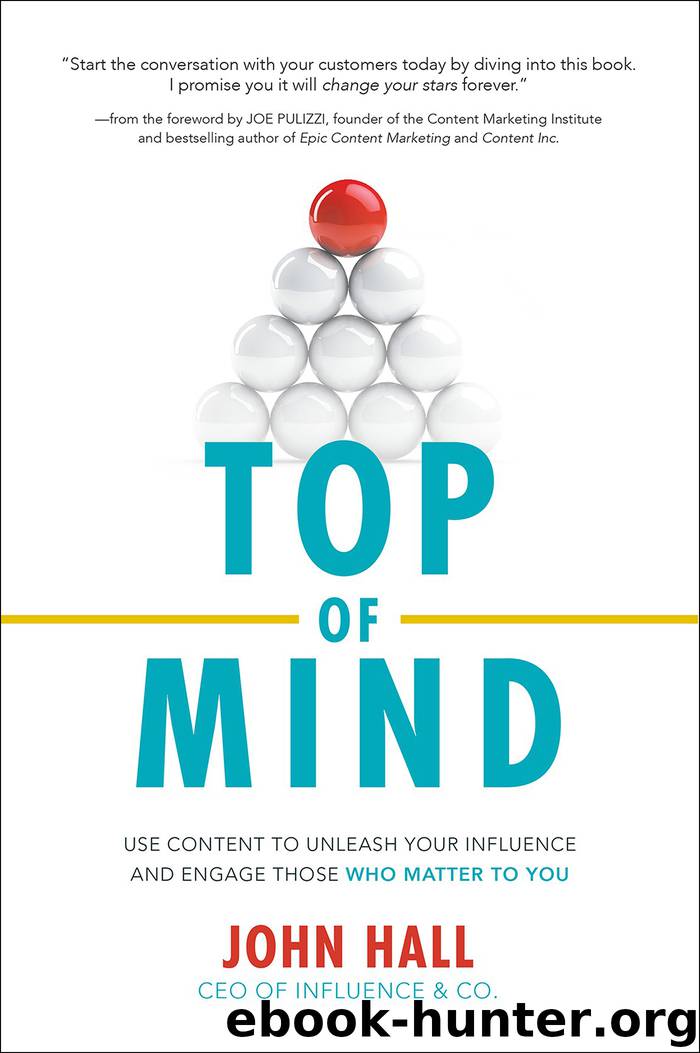Top of Mind by John Hall

Author:John Hall
Language: eng
Format: epub
Publisher: McGraw-Hill Education
Published: 2017-04-10T04:00:00+00:00
6
BROADCASTING YOUR MESSAGE THROUGH CONTENT
UNTIL NOW, we’ve focused more on what it means to be top of mind; how qualities like helpfulness, transparency, likability, and consistency help get you there; and content in broad strokes rather than its specific, tactical application. Understanding what it means to be top of mind is the first step; actually earning and keeping your place at the top of your audience’s mind is the next.
Written content has given my company and me the fuel to nurture our networks and stay top of mind with them more easily. I want to share with you how I’ve done it and how you can put it into practice, too.
Before you jump to video or some other trend in communication, I can promise you this: at this moment, there is no better way to scale a top-of-mind strategy at a reasonable cost than written content. There is a time and a place for video and other similar tactics, but if you can’t scale your written content now, you’ll struggle with video and other tactics. You’ve got to walk before you can run. There is no denying these other tactics are valuable, but right now, written content remains the most scalable, affordable, and effective vehicle that should be at the core of your strategy.
The exponential rise of content marketing reflects a collective desire to reconnect with the power of the written word. Decades of exposure to relentless advertising have transformed our attention spans. As we learned to tune out ads and aggressive sales pitches, we developed a hunger for substantive, engaging information. We turned to digital content—written pieces in the form of articles, blog posts, white papers, social media posts, and so on—for knowledge, insight, and entertainment.
If you’ve spent more than 10 minutes reading things online within the last few years, you’ll probably think my ode to content is a bit precious. I’ll accept the critique; after all, the digital content landscape is kind of a wasteland. To pretend that humanity benefits from a thousand variations on “7 Ways to Startup Success Through Memes” would be deluded.
However, it’s a wasteland only because so many people are writing content for content’s sake. The explosive growth of the content marketing industry has fueled the widespread misconception that any content is good content, which is why we’re drowning in “think pieces” that read like late-night infomercials.
Good content is created for the sake of the reader. Your audience comes to your content with an agenda—they want to be educated, or perhaps just entertained. Regardless, they always want to be enriched. Write to their needs and you’ll earn a top-of-mind spot.
But what if you’re not a great writer? What if the prospect of composing even a 600-word blog post makes you break out in sweaty dread?
If this is the case, you’re not alone. I’ve always considered myself a lousy writer, which would be unremarkable if I weren’t the CEO of one of the fastest-growing content marketing companies. Throughout the early days of Influence & Co.,
Download
This site does not store any files on its server. We only index and link to content provided by other sites. Please contact the content providers to delete copyright contents if any and email us, we'll remove relevant links or contents immediately.
Influence: The Psychology of Persuasion by Robert B. Cialdini(4715)
The Miracle Morning by Hal Elrod(4637)
The Hacking of the American Mind by Robert H. Lustig(4318)
Pre-Suasion: A Revolutionary Way to Influence and Persuade by Robert Cialdini(4144)
Unlabel: Selling You Without Selling Out by Marc Ecko(3587)
Ogilvy on Advertising by David Ogilvy(3503)
Hidden Persuasion: 33 psychological influence techniques in advertising by Marc Andrews & Matthijs van Leeuwen & Rick van Baaren(3472)
Purple Cow by Seth Godin(3137)
Who Can You Trust? by Rachel Botsman(3086)
Kick Ass in College: Highest Rated "How to Study in College" Book | 77 Ninja Study Skills Tips and Career Strategies | Motivational for College Students: A Guerrilla Guide to College Success by Fox Gunnar(3070)
The Marketing Plan Handbook: Develop Big-Picture Marketing Plans for Pennies on the Dollar by Robert W. Bly(2975)
This Is Marketing by Seth Godin(2969)
I Live in the Future & Here's How It Works by Nick Bilton(2934)
The Power of Broke by Daymond John(2895)
Building a StoryBrand by Donald Miller(2838)
The Tipping Point by Malcolm Gladwell(2823)
The 46 Rules of Genius: An Innovator's Guide to Creativity (Voices That Matter) by Marty Neumeier(2796)
Draw to Win: A Crash Course on How to Lead, Sell, and Innovate With Your Visual Mind by Dan Roam(2732)
Market Wizards by Jack D. Schwager(2643)
